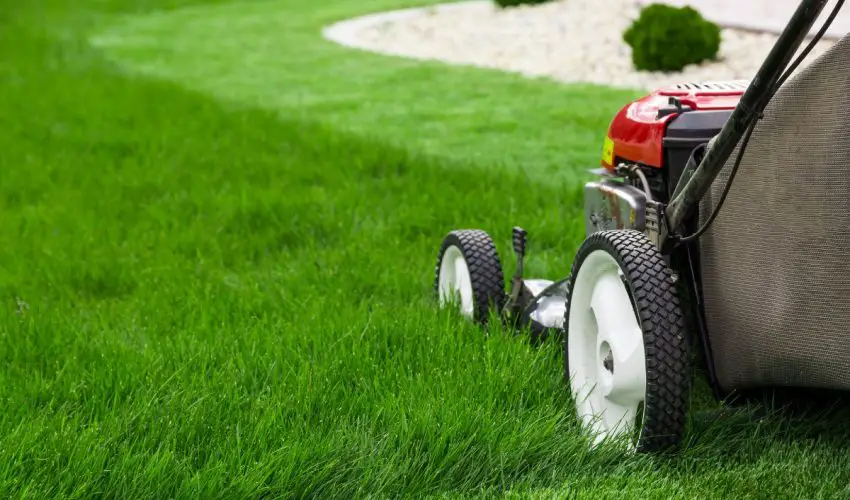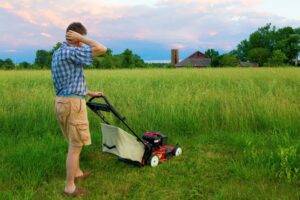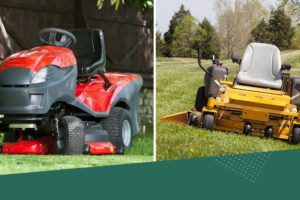The first step is to figure out why your lawn isn’t quite as thick as it could be. There’s generally a cause for your lawn’s thinness. These factors can vary depending on the climate, surroundings, and other problems that homeowners’ lawns may face.
Table of Contents
ToggleAll you may need to do to acquire the impression of thick, green grass is to fertilize or overseed your lawn. These approaches are simple enough that almost every homeowner may do them without the assistance of lawn care. However, if your lawn is in bad form, it may be wiser to start over, properly replacing the lawn and taking care to keep it lush and beautiful. In this article, we will be talking about how to thicken the grass in your lawn.
5 Tips to Make Your Grass Thicker And Fuller
1. Remove any weeds, dead plants, and other debris
Before you begin any grass re-growth care work, make sure the area is free of weeds, dead or dying plants, and other debris that could obstruct the process. If you pick weeds out by hand, be sure you get the full root of the plant, or the weed will only grow back and spread.
You can get down to the tough and sturdy weed roots by using a weeding tool. If you’re using a weed killer to get rid of weeds, make sure you follow the instructions carefully to avoid harming other plants.
2. Overseed
You should never leave any open spots in your garden if your ultimate goal is to grow your lawn thicker and fuller. It is very common to find open patches or lightly populated areas on your lawn. If you come across such areas, the best way to solve this type of gardening problem is to overseed them. Overseeding allows us to fill up those open spaces while also making your grass greener and more attractive.
However, be sure to overseed any open patches with the same variety of grass, since this will offer uniformity and seem more appealing.
3. Improve your soil
Soil testing is a simple procedure that pays off nicely in the form of thick, healthy grass growth. A soil test provides you with a precise starting point for your lawn’s specific requirements, as well as recommendations for addressing any underlying issues. The pH of your soil and other soil characteristics that can impede thick, beautiful growth is revealed through testing. You may improve your soil without guesswork by following test recommendations.
Your grass, for example, will not be able to absorb nutrients if the pH of the soil is too low. Testing will reveal whether your lawn requires lime or other soil additions to restore pH balance and nutrient availability, allowing grass to grow thick and lush again.
4. Mow your lawn properly
Mowing appears to be a simple task that you can’t possibly go wrong with. However, your mowing habits might have a significant impact on the growth of your grass. Proper mowing can result in thicker grass. Mowing your grass too short can result in a green or yellow tint, which is undesirable. It can also make weeds more likely, giving you more headaches than you need. You should only cut one-third of your grass blades.
Mowing should be done once a week, and the height should be between 3.5 and 4 inches. Sharpening your mower blades will provide a clean cut.
5. Irrigate appropriately
During the active growing season, most warm and cool-season lawns require around one inch of water every week. Lawns require water to stay alive and avoid drought. Overwatering is a common cause of sickness. When watering your grass with a hose or a sprinkler, it might be difficult to discern how much water is being applied.
An irrigation audit is a cost-effective and useful technique to determine how much water your lawn receives. It will also assist you in determining which areas of your lawn receive water in comparison to other areas.
FAQs
What to do when you got too much shade on your lawn?
It’s critical to establish the right balance of light and heat when it comes to cultivating a thick lawn. Too much sun can scorch and dry out your grass, while too much shade might deprive it of the nutrients it needs to thrive.
You can do the following: When the sun isn’t shining as brightly, drink water early in the morning or late in the evening.
Make sure your grass isn’t trimmed too short. The underlying soil is protected from drying out by grass blades that are slightly longer.
Use specialized fertilizers and lawn care solutions designed for heat and sun.
Is a thick lawn good?
A thick lawn is your best defense against weeds, which can’t compete for space and nutrients. Allowing the grass to grow tall enables the roots to grow deeper where they can better withstand drought. Taller grass also casts shade, reducing the germination of weed seeds.
Is grass clipping good for lawns?
Grass clippings are beneficial to lawns because they decompose and provide natural fertilizer. Clippings include the same nutrients and water as the rest of your grass, as well as the nutrients (particularly nitrogen) that your lawn requires to be healthy.
When you leave your grass clippings on the ground, they have the opportunity to decompose, releasing water and nutrients into the soil. This promotes the growth of greener, healthier, and thicker grass. However, don’t allow your grass to grow too long, since the clippings will build up and take longer to decay, leaving mounds of grass all over the place.
Conclusion
Take some time and observe how your lawn looks every day, in the morning and the evening. Become aware of all the numerous factors that influence it (wind, sun, water, animals, people, chemicals) and how they change throughout the day.
The more you know about your lawn and its particular microclimate, the better you’ll be able to care for it. Checking for damage regularly-and addressing it quickly-is one of the best things you can do to maintain a lawn full of thick, green grass. Growing healthy, green grass isn’t difficult, but it does require you to keep an eye on and take care of your lawn.





